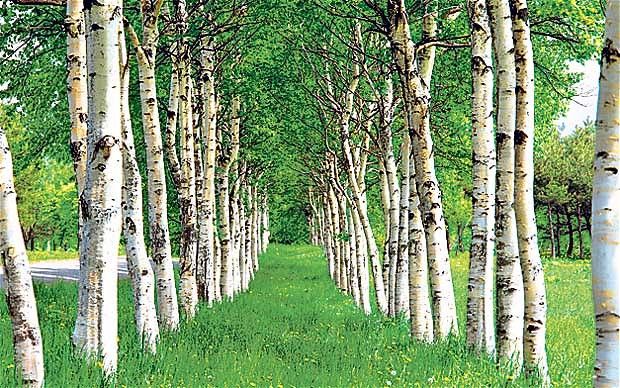The silver birch, or Betula pendula, is a deciduous tree that looks like a lady of the woods because of its graceful shape and small size. Silver birch trees look attractive year-round with white bark, spring catkins and yellow autumn leaf colour. Birds and bees like the catkins and seeds, and some species of moths lay their eggs on the leaves of birch trees.
The open branches of silver birch trees only cast light shade, which means that underplanting can be done around them. This makes them appropriate for all but very small gardens. Most trees have one stem, but silver birches with multiple stems are available or easy to grow. They make beautiful garden accent trees and won’t get as big as a single tree. Multi-stemmed birches can even be grown in a large container or raised bed.
Silver birch has white bark, which becomes marked with rugged dark cracks as it matures. As the tree grows, the bark often peels off in strips. Silver birch leaves are triangular-shaped and green, fading to bright yellow in autumn. In spring, male catkins are 6cm long and brown-yellow, and female catkins are 3cm long and green. If pollinated, female catkins become red-brown in colour and bear masses of tiny, winged seeds.
Betula pendula is the parent plant of several named, cultivated birches that have different growing shapes and habits and are used for decoration. Weeping silver birch (Betula pendula ‘Youngii’) is distinctly different looking, forming a wide-spreading tree of weeping branches.
Silver birch trees are a beautiful addition to any garden, even small ones. With their striking white bark, attractive leaves, and slim growth habit, birch trees bring elegance and visual interest. However, some people may hesitate to plant a birch tree in a small space, wondering if they have room. The good news is silver birches can thrive in small gardens if given the right conditions. In this article, we’ll explore how to successfully grow silver birch trees in small gardens.
Choosing the Right Birch Variety
When selecting a birch tree for a small garden opt for a smaller cultivar that reaches an ultimate height of around 10m. The species Betula pendula and its cultivars are a good choice rather than larger birch species. Specifically, weeping birch varieties like Young’s weeping birch grow to around 4m, making them ideal for tiny gardens. An upright narrow birch like ‘Fastigiata’ is also suitable, growing in a columnar shape to about 5m high and 2m spread.
Before buying, check the eventual size of the variety you choose to ensure it will suit the space you have. The Width of the garden is often the limiting factor in small gardens, so pick a slim birch.
Opt for a Multi-Stemmed Birch
Rather than buying a standard single-stemmed birch, consider a multi-stemmed clump form. Several slender trunks sprouting from the base makes a gorgeous feature, with several white trunks instead of one. Multi-stem birches have a naturally more compact habit than a single stem tree, so are great for small gardens. They rarely grow beyond 6m high and 4m spread.
Buying a multi-stem or creating your own by planting three young whips is an excellent way to maximize vertical impact while minimizing width. Plant them in a large container if space is very limited.
Give It Space to Grow
Although birches are slim trees give it sufficient space from boundaries buildings, and other trees. Plant at least 2 metres from fences, allowing room for the canopy to spread. Keep well away from drains or foundations to avoid potential root damage.
If birch trees are planted too closely together, they grow tall and spindly as they compete for light. Space them appropriately so they can develop their naturally airy habit.
The Right Planting Conditions
Birches need moisture-retentive but well-draining soil. Improve drainage in clay soils before planting by digging in compost or grit. Birches dislike windy sites, so avoid exposed locations if possible. Shelter the tree when young until established.
Sunny or lightly dappled shade locations suit birches best. They don’t thrive in dense shade. Limiting competition from weeds and grass is beneficial while the tree establishes. Mulch well after planting and remove vegetation within a 1m radius.
Watering and Support
It’s vital to water birch trees well in dry periods while their roots establish in the first couple of years after planting. Installing a pipe by the roots makes watering easy. Inserting a stake next to young trees offers useful support in windy gardens.
Minimal Maintenance
Apart from initial watering and mulching, silver birch trees need very little maintenance. They require no formative pruning. Weeping varieties may need occasional thinning to open their shape but avoid over-pruning.
Established birch trees are unfussy and look after themselves. Simply remove any crossing or damaged branches in late summer if needed. Enjoy their graceful presence in your small garden for years to come!
How to grow silver birch tree
Grow silver birch in any reasonable soil. Ideally plant when dormant, preferably in autumn. Stake your tree and keep well watered during dry spells for the first couple of years. Prune only if necessary, in late summer.
How to prune silver birch

Silver birch should not be pruned too much because it can bleed sap, and the wounds that take a long time to heal could let disease in. Birch trees naturally grow into beautiful shapes, so they don’t really need to be pruned. However, if you have to do any important work, do it in late summer or early fall, when the sap “bleeds” less easily.
Wash your silver birch tree for a brilliant winter garden look!
- The Ultimate Guide to Growing Strawberries in Raised Beds - August 8, 2025
- No-Dig Garden Beds: The Easiest Way to Grow a Beautiful Garden - August 6, 2025
- How to Protect and Preserve Wood for Raised Garden Beds - August 6, 2025

